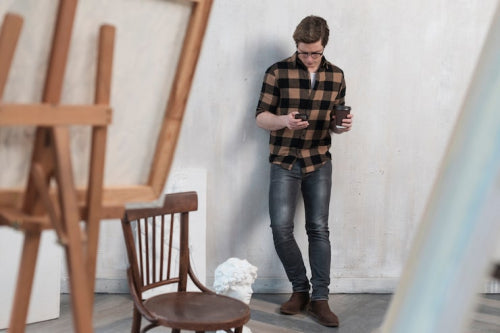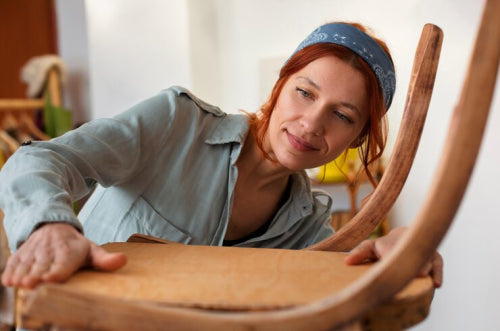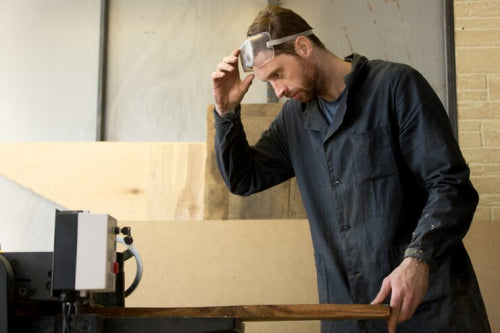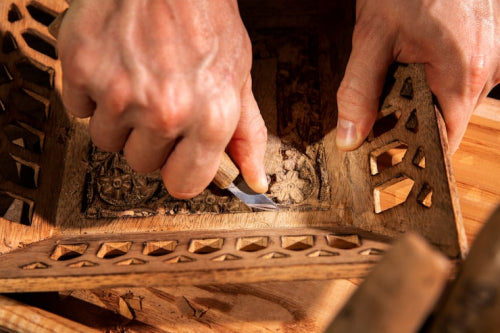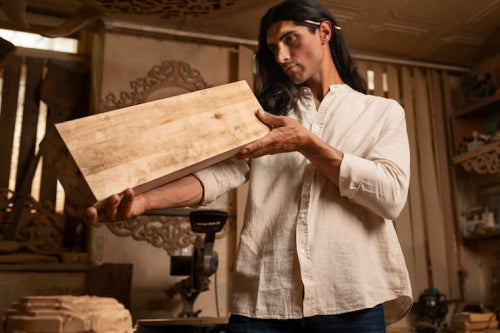Quick Listen:
Imagine stepping into a sun-drenched living room where a sleek teak credenza commands attention, its unadorned lines and rich, veined grain drawing the eye like a quiet invitation. Nearby, a pair of molded plywood armchairs curve gracefully, their forms at once ergonomic and artistic, evoking an era when everyday objects doubled as sculpture. This is the magnetic pull of mid-century modern furniture a movement forged in the optimistic forge of the 1940s and 1950s, now surging back into prominence across contemporary homes worldwide. Far from mere retro whimsy, this revival signals a deeper yearning for pieces that endure, honor the earth, and harmonize with the chaos of modern life.
Mass-market furniture lacks heart, filling rooms with bland, short-lived pieces. Frequent breakdowns spark frustration, as replacements erode style and sentiment. At MMC Wood Creations, Udaipur artisans shape heirloom furniture with enduring craftsmanship and cozy elegance, creating pieces that echo your identity, ensuring your home radiates warmth and timeless connection. Shop Now!
Why Mid-Century Modern Resonates Today
The essence of mid-century modern lies in its unpretentious fusion of form and function: crisp geometries, fluid organic contours, and an unwavering reliance on natural elements like wood. Born amid post-war reconstruction, it championed accessibility and ingenuity, turning humble materials into icons of democratic design. Consider the Eames lounge chair, with its supple leather sling and rosewood base, or the understated Danish teak sideboards that dotted mid-20th-century living rooms these aren't relics; they're blueprints for living well, adaptable from a vintage bungalow to a sleek 2025 high-rise.
Market forces underscore this enduring appeal. The global wood furniture sector, encompassing everything from solid timber tables to engineered composites like plywood and medium-density fiberboard, stood at $235.3 billion in 2023 and stands poised to climb to $327.7 billion by 2033. This trajectory, propelled by a steady 3.4% compound annual growth rate through the coming decade, reflects broader societal shifts: accelerating urban density, swelling personal wealth, and a sharpened consumer focus on products that sustain both style and the planet. Real estate booms and hospitality expansions further amplify the call for premium wooden accents that enhance residential nooks, corporate boardrooms, and boutique hotel lobbies alike.
What elevates mid-century modern in this landscape? It's a bulwark against ephemera. In an age of algorithm-driven disposability, these designs whisper permanence crafted with an eye for longevity, their subdued, nature-inspired sheens weaving seamlessly into any interior narrative. The movement's spare philosophy dovetails with today's quest for serene, streamlined environments, while its wood-centric palette resonates with eco-aware cohorts demanding traceability from forest to finish. Artisans at firms like MMC Wood Creations, nestled in Udaipur, India, are channeling this ethos, hand-shaping bespoke wooden heirlooms that fuse mid-century poise with forward-thinking environmental stewardship.
Yet the revival transcends aesthetics; it's a cultural recalibration. As urbanites grapple with smaller footprints and larger carbon footprints, mid-century's efficient silhouettes think low-slung sofas that maximize floor space offer pragmatic poetry. Designers note a pivot toward warmer palettes, with walnut's earthy tones poised to dominate 2025 interiors, signaling a sophisticated return to browns that feel fresh, not faded. This isn't blind nostalgia; it's a deliberate embrace of designs that age gracefully, much like the teak that patinas over time.
A Revival Rooted in Craftsmanship and Customization
This renaissance reinterprets heritage through a contemporary lens, prioritizing personalization over rote replication. Mid-century modern's clean profiles now bend to individual whims, from selecting oak stains to integrating hidden compartments for hybrid work setups. The wooden furniture industry overall, segmented by hardwood versus softwood variants and spanning residential to commercial uses via retail chains, online portals, and specialty outlets, hit $461.84 billion in 2024. Forecasts peg it at $719.61 billion by 2032, with a robust 5.7% CAGR from 2025 onward, spurred by an unquenchable thirst for resilient, adaptable, and green furnishings that mirror personal narratives.
Customization emerges as the linchpin. Shoppers crave items attuned to their rhythms modular ensembles where dimensions, hues, fabrics, and configurations bow to bespoke visions. Digital innovations, from augmented-reality previews to intuitive configuration apps, democratize this process, rendering it as effortless as scrolling a feed. At MMC Wood Creations, this manifests in tailored commissions that marry mid-century's taut linearity with utilitarian twists, such as foldaway desks or multifunctional benches that conquer cramped quarters without sacrificing soul. It's more than utility; it's catharsis a custom walnut console isn't mere millwork; it's a manifesto of self-expression amid homogenization.
Craftsmanship, too, receives a high-tech infusion. While honoring tactile traditions, makers deploy CNC routing and laser etching to achieve micron-level precision, preserving the hand-hewn warmth of yesteryear alongside unyielding structural integrity. The outcome? Artifacts that venerate mid-century's democratic spirit yet thrive in our gadget-laden epoch. As one design observer puts it, this blend ensures pieces that "honor the past but are built for the future." In kitchens, for instance, retro cabinets with streamlined fronts and soft-close mechanisms are redefining meal prep zones, merging nostalgia with seamless ergonomics.
This evolution extends to material choices. Reclaimed hardwoods and FSC-certified sources dominate, aligning with mid-century's innate thriftiness. Consumers, empowered by transparency mandates, flock to brands detailing provenance, fostering loyalty through ethical narratives. MMC Wood Creations exemplifies this, sourcing regionally to minimize ecological footprints while delivering the lustrous grains that define the style.
Real-World Revival: From Homes to Icons
In practice, mid-century modern infiltrates every corner of daily life. Envision a sun-flooded den where a rosewood media unit cradles streaming devices beneath its minimalist facade, or a home office enlivened by a sculptural birch desk that nods to Noguchi's fluidity. Interior architects layer these with velvet upholstery or metallic accents, birthing hybrids that evoke wistful reverie alongside bold contemporaneity. MMC Wood Creations distinguishes itself here, curating lines that distill mid-century's restraint into versatile vignettes, from ambient dining sets to versatile wall units, all calibrated for today's eclectic households.
Legendary archetypes fuel the fire. The Eames oeuvre, with its plywood shells and leather accents, endures as a touchstone of innovation, while Hans Wegner's teak icons grace upscale eateries and design-forward lodgings. These aren't artifacts in amber; they're living lore, summoning the era's buoyant ingenuity. The modern furniture arena, valued at $5.81 billion in 2024 and eyeing $6.19 billion in 2025 en route to $10.24 billion by 2033 a 6.5% CAGR thrives on urbanization's march, predilections for pared-back modularity, and income surges in nascent markets. E-commerce's ascent and eco-material mandates accelerate this metamorphosis, with the U.S. claiming 46% share and boasting over 1,500 fabricators churning out adaptable, mid-century-inflected wares.
Beyond residences, the style colonizes commercial realms. Boutique hotels deploy Wishbone chairs in lounges, their yoke backs a subtle homage to Scandinavian restraint. In offices, credenzas double as wellness stations, their wood warms sterile fluorescents. Even curved motifs once marginal are resurging, softening edges in sofas and shelving for a tactile, human-scale intimacy that mid-century intuitively grasped. This permeation underscores a truth: mid-century modern isn't a phase; it's a framework for resilient beauty.
Challenges in a Crowded Market
For all its momentum, reclaiming mid-century modern demands navigating thorns. Procuring premium, responsibly harvested woods teak's density or walnut's depth escalates expenses amid supply volatilities, even as eco-vigilance intensifies. Authenticity teeters on a knife's edge: die-hards decry dilutions like embedded charging ports as heresy, yet pragmatists hail them as evolutions. Saturation looms large, too; as hordes of labels ape the aesthetic, differentiation hinges on provenance and prowess arenas where MMC Wood Creations shines via its atelier-honed finesse and narrative-driven ethos.
Regulatory headwinds compound this. Stringent sustainability edicts, from EU timber regs to U.S. green certifications, exact tolls on small-batch producers. Yet these pressures refine the field, weeding out dilettantes and rewarding those, like MMC, who embed ethics into every joint and dovetail.
Seizing Opportunities in a Sustainable Future
Obstacles notwithstanding, vistas abound. Mid-century's longevity ethos syncs symbiotically with sustainability mandates, positioning it as a antidote to planned obsolescence. Patrons invest not in trends but legacies pieces outlasting cycles, their woods recyclable or upcyclable. This philosophy dovetails with MMC Wood Creation's credo: forging timeless troves from eco-sourced stocks, infused with mid-century's spare genius.
E-commerce's proliferation, as flagged in sector analyses, democratizes discovery, bridging millennials chasing vintage allure with boomers reclaiming youth's furnishings. Collaborations beckon: envision MMC allying with tastemakers for hotel commissions or licensing Wegner-esque motifs for scaled elegance. Such synergies could catapult visibility while anchoring in authenticity. The sector's zeal for verdant, voiced furnishings endures, charting a luminous course for innovators who exalt caliber over quantity.
Moreover, 2025 heralds nuanced evolutions: biophilic integrations like live-edge accents, or adaptive smartwoods that shift with seasons. These augment mid-century's core without eclipsing it, ensuring relevance in flux.
A Timeless Legacy Reimagined
Gazing ahead, mid-century modern's imprint deepens, morphing via astuter, verdanter substrates reclaimed exotics or bio-resins while fidelity to origins holds firm. Its craft-centric DNA, with every mortise a testament to toil, reverberates against trend's transience. MMC Wood Creations stands vanguard, orchestrating mid-century's grace with modernity's imperatives, from Udaipur's ateliers to global galleys.
In authenticity's pursuit, mid-century modern proffers rarity: a span 'twixt epochs, utility and art, allure and intent. It's less about populating spaces than populating souls. Nestle into that contoured seat, trace a table's burr; you're not caressing timber alone. You're clasping chronicle, refashioned for now and tomorrow.
Frequently Asked Questions
Why is mid-century modern furniture becoming popular again in 2025?
Mid-century modern furniture is experiencing a revival because it offers timeless design that combines form and function, making it perfect for today's streamlined living spaces. The movement's emphasis on natural materials like wood, clean lines, and durability resonates with eco-conscious consumers seeking sustainable alternatives to disposable furniture. Additionally, these pieces adapt well to both vintage homes and contemporary high-rises, while their efficient silhouettes maximize space in urban environments.
What types of wood are most popular in mid-century modern furniture design?
Teak, walnut, and rosewood are the most iconic woods in mid-century modern furniture, prized for their rich grains and durability. Walnut is particularly trending for 2025 interiors due to its warm, earthy tones that create sophisticated brown palettes. Many contemporary makers also use reclaimed hardwoods and FSC-certified sources to meet sustainability demands while maintaining the lustrous grains that define the mid-century aesthetic.
How much does authentic mid-century modern wood furniture cost compared to reproductions?
While the blog doesn't specify exact prices, it indicates that authentic mid-century modern pieces command premium prices due to the cost of responsibly harvested woods like teak and walnut, plus skilled craftsmanship. The global wood furniture market's growth from $235.3 billion in 2023 to a projected $327.7 billion by 2033 reflects strong demand for quality pieces. Custom and authentic pieces from specialized craftsmen like those mentioned in the article typically cost more than mass-produced reproductions but offer superior materials, construction, and longevity.
Disclaimer: The above helpful resources content contains personal opinions and experiences. The information provided is for general knowledge and does not constitute professional advice.
You may also be interested in: Storage
Mass-market furniture lacks heart, filling rooms with bland, short-lived pieces. Frequent breakdowns spark frustration, as replacements erode style and sentiment. At MMC Wood Creations, Udaipur artisans shape heirloom furniture with enduring craftsmanship and cozy elegance, creating pieces that echo your identity, ensuring your home radiates warmth and timeless connection. Shop Now!
Powered by flareAI.co
